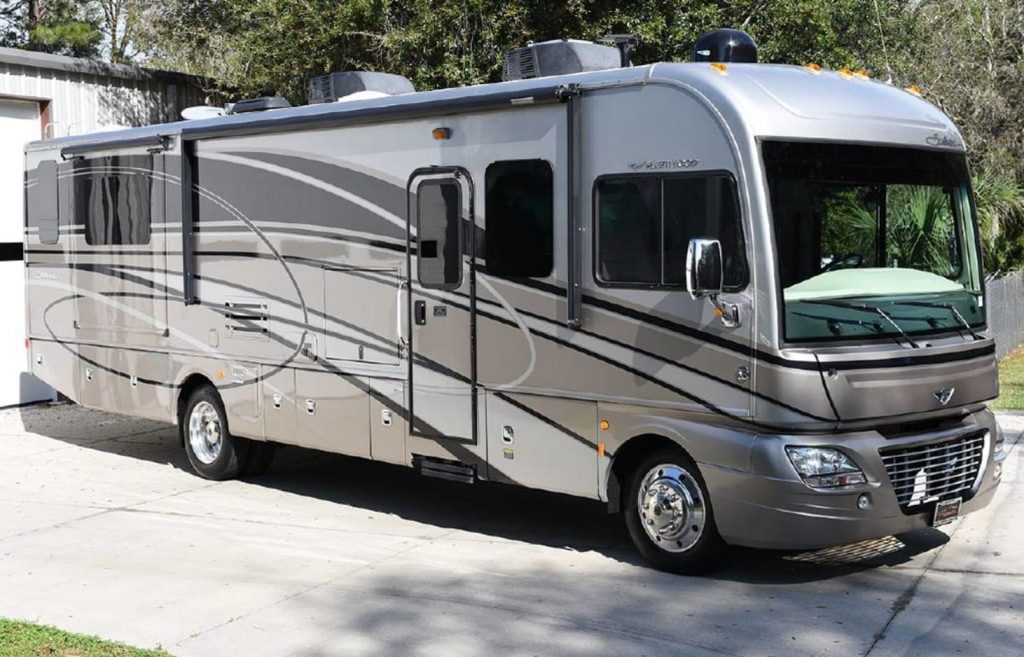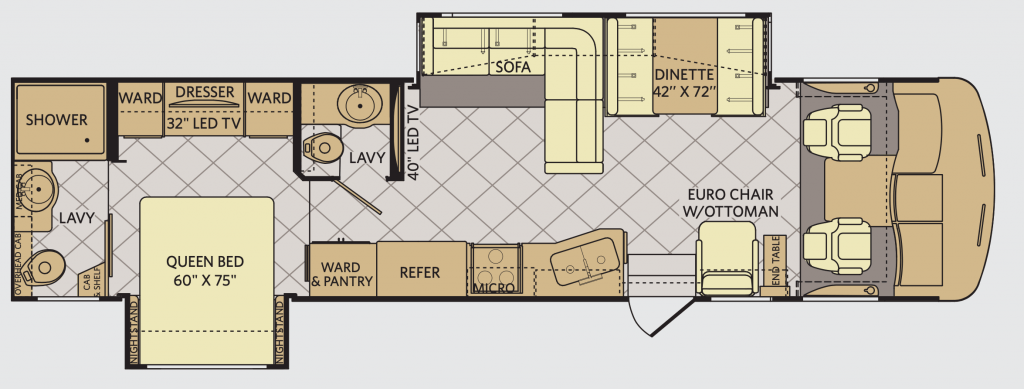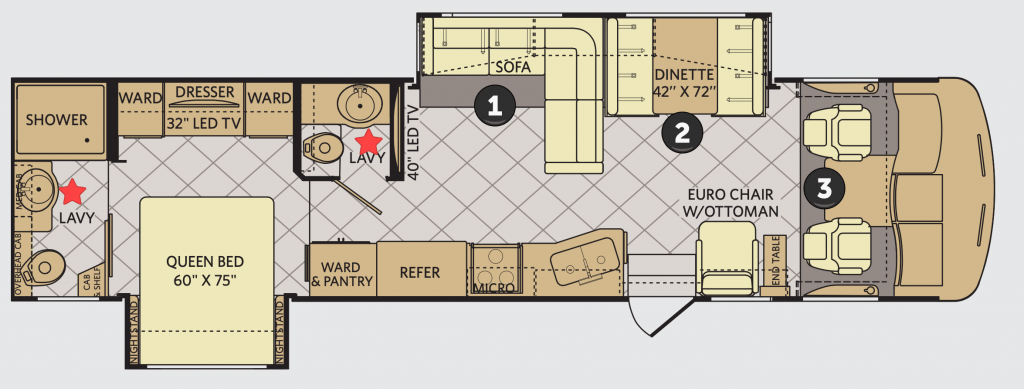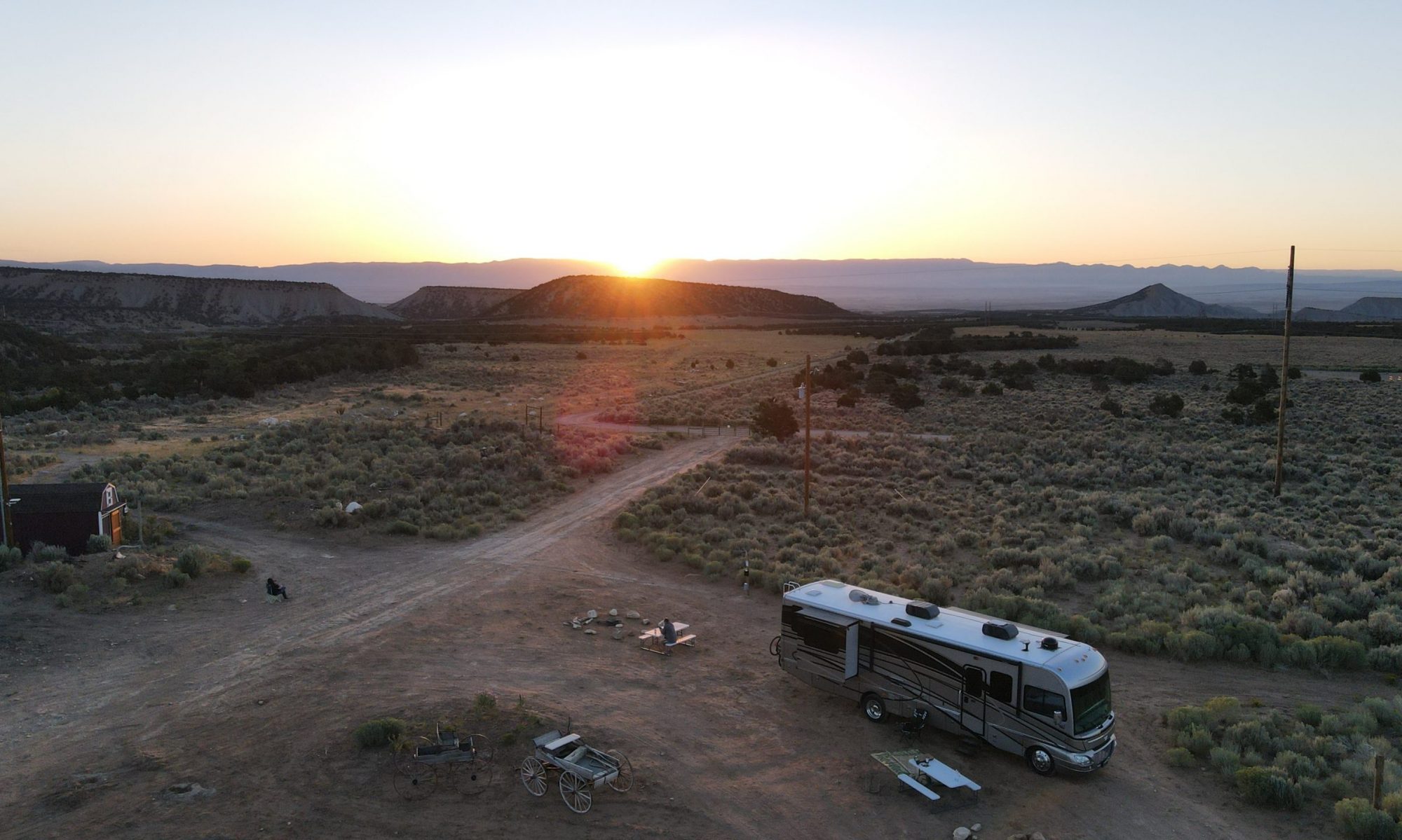This post/article is a piggy back to my article on our two week RV trip out west which you can read about here if you didn’t already. This article will focus on the RV itself, how well it worked for the task at hand, and what I would change if I could do it all over again.

The RV we used was a 2015 Fleetwood Southwind 36L stats here via rvusa.com.
MSRP: $144,549
Fuel Type: Gas
Ford F53 Chassis / Ford Triton V10 (Gas) 362-hp and 457 lb-ft of torque, with fords dependable TorqShift five-speed automatic transmission with overdrive, plus Tow/Haul capability.
140 cubic feet of inside storage (cabinets. cupboards, closets, under-seat/bed, etc.)
118 cubic feet of outside storage. The brochures mention pass-through storage, but I didn’t see that, although there were some full length ‘slots’ in the rearmost and middlemost slots.
The 36L has the following floorplan:

I’ll talk more about what was awesome about this and what was less awesome about this later.
Finding a rental and executing it.
When we were planning for our epic vacation, I talked to numerous folks about what type of RV we should take. Everyone pushed us towards a Class A over a Class C for comfort, a step up in build quality, and most importantly noise level, especially for mountain travel. Apparently, the doghouses (the area between the driver/passenger seat that covers the engine) aren’t as quiet, especially when you’re grinding up a mountain, or holding the engine back in low gear. I’ve driven many vans, so I knew what they were talking about. Ideally, a diesel pusher with the engine and all associated noise in the back is best.
I started my rental search on rvshare.com as well as outdoorsy.com about 2 and a half months before the trip. Kind of last-minute, actually. Both are great owner rental sites. I didn’t want to drive an RV USA billboard across the country and back. I wanted to look and feel like an owner and rent an RV that was *hopefully* cleaner and likely more cared for than a fleet rental RV. More than the vanity that that sounds like, I wanted an RV that the owner knew about and could tell me, it does this well, that well, doesn’t do this well. Over someone who would just hand me the keys. and say, “Good Luck, Have Fun!”.
My initial selection was a diesel pusher in Cincinnati. I think I interviewed the owners more than they interviewed me. We talked about the trip, and our desire/need to be 100% self-sufficient for boon-docking (the act of parking an RV anywhere legal without hookups). He totally got that. We talked about the route, mountain passes, roads, etc. We agreed on the deal, but his RV was in the shop getting a ride enhancement kit, plus he was headed out-west 2 weeks before us, and we’d be cutting it close. Then it happened, when he picked up his RV from the suspension work, other things weren’t working, and he wasn’t comfortable I’d have a trouble-free trip. So I started looking again. (We’ve kept in touch, and I will rent that RV next).
I talked to a number of Class A owners, and asking to take their $100k+ RV across the country and back over two weeks is a big ask. Mileage is what kills the value in RV’s and I’m asking some of these folks who have less than 20k miles on their RV in some cases to let me put 25% of the mileage on the vehicle. I’m paying for that, of course, but If they could rent it to someone for 7 days, that’s simply going to drive it 300 miles (150 miles to a campground, park it for a week, and drive it back), that seems more lucrative and simply a better rental strategy.
Surprisingly, most folks weren’t really all that concerned with our ability to drive one. While I’ve driven some big things in my life, including a 40-foot UHaul, and a box truck back in the day, I had no REAL RV experience, and I was clearly jumping into the deep end. It looks very intimidating, mostly because you’re driving something that potentially costs more than our house to replace, but at the end of the day, it just wasn’t that bad (more on that later).
Renting from rvshare/outdoorsy…
You need to be very mindful of a few things:
(1) The night rate usually only covers a very limited number of miles per day, some as low as 25, some as high as 150, the average seems about 100. Then there’s an overage charge for miles over that. We were looking at approximately 5000 miles over 14 days. That mileage charge adds up FAST.
(2) If you’re going to be driving through very warm areas (+84F), boon-docking, or if you need to 100% self-sufficient, you’re going to be running the generator. They also only include a small number of hours. Again if you’re parking at a campground with full hookups all the time, not a huge deal. (We used 180 hours of 16 days which was about 11 hours a day on average. We had to run the generator driving through some warm climates to keep things cool and we did a fair amount of boon-docking that required the generator for AC. We were not ‘roughing it’. If you have a Class A RV, you’re not going to want to sweat while you sleep. Those excess generator hours can add up too.
(3) Road Side Assistance, both rvshare and outdoorsy, claim to provide it, but it’s not free; it’s part of the fee. Neither have great reviews for their ability to provide any of this.
(4) The excess Insurance. That’s right, EXCESS. Usually hidden under taxes and fees. While I can appreciate the buffer between the renter and the rentee that exists to solve disputes and offers some level of assurance to the renter, it’s sadly overpriced and underperforming. Read the fine print, RVShare makes you essentially buy STATE MINIMUM Coverage at an exorbitant rate for your small rental period. That’s simply not enough insurance for the damage you can do in or to a 25,000 lb vehicle that can cost upwards of $200k or more to replace. Now I’m assuming you have good insurance, not 1-800-Call the General. With someone like StateFarm, Nationwide, Farmers, etc. With good limits of 250k/500k or similar, your policy will extend to you renting an RV for less than 30 days.
Check with your Agent Don’t take my word for it. Get it in writing too. Or just pay the RVShare Broker TAX and take their insurance, knowing that if you end up testing it, you’ll likely be disappointed.
It should be noted that I’m not bashing on these companies. They perform a service and helped me find an RV. Their business model is what it is. I’m not going to change them. Given the right rental circumstances, they are just fine. For us, driving 5,000 miles, we wanted better coverage and better exposure. I bought my own RV Roadside assistance through Good Sam, we also had more than adequate insurance coverage.
Renting is a great (albeit expensive for long trips) way to try RVing without the expense and pain of actual ownership. All in, for our adventure, we spent $6100 on the rental, about $2000 on fuel for the trip, and another call it$1200 for RV parks and other RV things. Had we owned one, and didn’t have the rental fee we’d be talking less than $4,000 for two weeks of vacation. You can’t beat that for that type of adventure and the experiences we had.
You can also help someone else make their payments for that big RV they bought and aren’t using like they thought they would. Don’t be that guy. We’re trying not to become that guy. 🙂 So in that vein, renting is CHEAP.
I think that covers all you need to know about renting, find your vehicle, be smart, protect yourself (and the renter) and make a deal.
Let’s talk about equipment and experience.
Ok, this is about Class A RVing; some of it might apply to a large Class C as well. It won’t be applicable to Class B’s, really, or if you’re looking for a popup-trailer or tent camping experience. If you want to freeze your buns off in a tent; go for days without showering or roll the dice on community showers, don’t need adequate refrigeration and AC, want to make a fire to make camp coffee instead of just pushing the button on the Keurig then you can probably skip the rest of this article.
Camping in a Class A RV isn’t proper camping if that’s your description. This is glamorous camping or “glamping”.
A Class A RV is a rolling hotel room. A bit tight in some areas, but you can get to the bed and take a nap if you’re not driving. You can start the generator rolling down the road, use the microwave, and make coffee without stopping. Pullover, and you’ve got a clean restroom at your disposal. All of these things are also generally available in a Class C. But less so in others and certainly not available in a tow vehicle as easily.
The downside is, unless you’re pulling a car, you’re pretty much stuck when you get where you’re going. They are harder to park, and not super conducive to sightseeing in tight places. Needles Highway comes to mind here, parking lots and pull offs, if they are full or small, aren’t conducive. One of the RV rental sites doesn’t allow you to tow anything so keep that in mind. Finding rentals isn’t that hard; you just have to plan ahead. Some KOA campgrounds rent cars and airports handle large vehicles and busses every day so getting in and out was easy. So it’s a trade-off anyway. You do sacrifice freedom when you don’t tow but it costs you in mileage, drivability, and park-ability.
Campgrounds have plenty of pull-through spots but not always a lot of spots for40+ feet and a tow vehicle. I’m convinced we got into some campgrounds because we didn’t have a tow vehicle. We could not have gotten in/out of three of the places we stayed had we been towing including our two of our favorite spots.
Drivability.
As I said, I’ve driven many things, and multiple trucks. I was a little concerned about at 36-foot vehicle (40 with bicycles hanging off the back), one that wasn’t just a ‘truck’. Here’s what you need to know:
(1) Go Slow, start slow, stop slow. They are big, heavy; nothing happens fast. Just accept the fact that you’re not going to be the fastest thing on the road (this was hard for me). You’re going to get passed by trucks, it’s going to happen. You can’t just jerk the wheel, nothing happens fast. Get a feel for your boundaries and just stay within them.
(2) Use your mirrors and cameras. Newer units have great visibility when you do.
(3) Comfort will come. The first 600 miles were nerve-racking, to say the least. Cars and trucks will move you when they pass. In time you just take it in stride. It wants to go straight, it wants to stay in its lane, let it. If you’re constantly correcting, you’ll be exhausted. Look down the road, look at where you want to go, and go there. Don’t look at the lane lines right in front of you. Look ahead. By the end of the trip, I was shocked at where I could park it, drive it, and could back it just about anywhere. For me, the two biggest concerns were: (A) Just how dang tall it was, I needed 13′ of clearance, which almost got me pulling into a Walmart that had a truck gate at 12′ two inches to keep trucks out of the main parking lot. Go around. (B), the amount of swing you have passed the back axle. there was probably 12+ foot of coach back there, which made parking lots tough, and you had to pay extra mind pulling away from gas pumps not to take them out. That was basically it.
Let’s talk about the coach and it’s amenities.
Exhibit A:

2015 Fleetwood Southwind 36L
OK, so this RV is 36 feet long, two slide-outs, the living room area with the dinette and the sofa/sectional (the driver’s side slide), and the bedroom slide, which really is just pushing the bed out so you can walk past it to the back lavatory.
What I loved about this RV:
Lot’s of room once the slides were out. I never felt cramped. Slides in for travel, yeah they can all be tight. Access to the back lavatory in compressed mode means you have to roll across the bed and you can’t open any of the dresser drawers or get to your clothes.
1 and a half baths! (the red stars on Exhibit A) Oh yeah, there were only 3 of us on this trip, but it meant it wasn’t tied up when someone was showering, and well, when you gotta go, you gotta go. If/when we buy an RV it will have 1.5 baths for sure. No question.
Set up was easy, park, push the auto-level button, wait, get confirmation, push the slides out, and done. Packing up was equally easy; just reverse the process.
What could be improved?
Starting with (1) on Exhibit A. That damn sectional. It wasn’t a good couch, and it was an even worse bed. Matthew slept on it just as a couch because the bed was so bad. We had a twin porta mattress to toss on the floor but he felt that was too bouncy. I can see why the sectional is there because the primary TV is on the bathroom wall. There was also a TV in the bedroom and one above the cab as well as one outside. The only use any TV got was on the bedroom hooked up to a PS4 so Matthew could play while we rolled down the road. Other than that we were camping, we didn’t need TV, let alone 4 of them. Yes, our RV will have TV’s but we never once tuned them on to watch TV or even stream a movie over Netflix.
I don’t want a sectional unless it makes a good bed, this one did not.
(2) The sectional and dinette should both be swapped. The dinette belongs in the kitchen. The recliner/Euro Chair should be with the couch. If this were my RV I’d switch them or pull the sectional for a Jack Knife couch that makes a better bed. The dinette also allegedly made a bed, but it was too hard to operate.
(3) Some RV’s offer a bunk in the cab; we would have preferred that. Above us was a TV and all the satellite gear that we never used. If there’s a real bed here, then none of the couch/sectional comments matter other than position; I’d still switch them.
Other items; the queen bed felt short, I’d opt for a King, but I’m fearful it wouldn’t be any longer; my feet hung off the end. It’s a preference, I slept well, though. After all, we’re roughing it. I could live with a queen-sized bed in my RV.
The brochure says this thing sleeps 6. No way, unless they are going to pile into the bed in the back. The couch/dinette are not acceptable ‘beds’ at this level of spend in my opinion. This is a great RV layout for 2 people. More than two and the rest will not enjoy it.
Overall Impressions
Look, I’m not trying to be overly critical or sound that way. I loved this RV and it really changed my mind about what you can do with a GAS-powered Class A. Granted, I didn’t tow anything with it but people tell me you can’t even feel a 3,000lb car back there. It’s less than 15% of the overall wait at 26,000 lbs.
It was still noisy though, even when not pulling up a hill or engine breaking down a hill, at 68 MPH, it was still quite loud. Not engine loud, just loud, you’re essentially pushing a billboard down the road. I found comfort in my Bose Quiet Comfort headset while driving and listening to an audiobook but that takes all conversation off the table. I would hope that a diesel pusher would be quieter.
It had a ton of squeaks, moans, and groans. It’s a mobile home rolling down the highway at 68 MPH; however, I expected the fit and finish to be a little better. After all, this RV only had 17,000 miles on it; it’s only 5 years old and looks brand new. There are things I as an owner would tighten up to solidify things where possible. Admittedly that’s very hard to do if your spouse doesn’t drive so you can track the noises. The dash was super squeaky. I even spent a good hour tightening a few things up, putting in shims to eliminate the most annoying noises. But since I don’t plan to drive it for 2 hours and park it for a week, I will drive it, it will need to be quieter. I hope I can find that in an RV, it might not exist.
At the end of the day, I would make sleeping arrangement changes but I could easily own this RV otherwise. It was nice in all respects despite my nitpicking.
Comments or thoughts? post them or email me: matt.rv@dishers.com

One Reply to “16 Days and 14 Nights in a Class A RV”